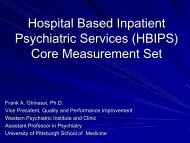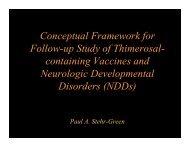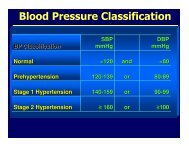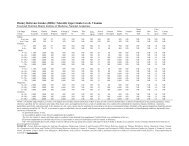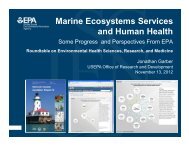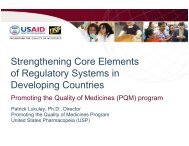Diekema.ppt [Compatibility Mode] - Institute of Medicine
Diekema.ppt [Compatibility Mode] - Institute of Medicine
Diekema.ppt [Compatibility Mode] - Institute of Medicine
You also want an ePaper? Increase the reach of your titles
YUMPU automatically turns print PDFs into web optimized ePapers that Google loves.
Febrile Seizures Associated with Trivalent<br />
Influenza Vaccine and 13-Valent<br />
Pneumococcal Vaccine 2010-2011 Season<br />
Decision Making by the ACIP General<br />
Recommendations Working Group<br />
Subgroup on Febrile Seizures<br />
Jeff Duchin MD<br />
Chief, Communicable Disease & Immunization Section<br />
Public Health – Seattle & King County<br />
Pr<strong>of</strong>essor in <strong>Medicine</strong>, University <strong>of</strong> Washington
Febrile Seizure Signal Detection<br />
• April 2010, Australia: Increase in febrile seizures 0-1<br />
days after vaccination <strong>of</strong> children
Febrile Seizure Signal Detection<br />
Enhanced monitoring in US<br />
• November, 2011: VAERS enhanced surveillance<br />
detects increase in febrile seizure reports after trivalent<br />
influenza vaccine (TIV) administration; most in children<br />
6-23 months<br />
• In US, Fluzone ® only TIV product administered to<br />
children 6-23 months during the 2010-2011 season<br />
• Vaccine Safety Datalink (VSD) revises risk interval to 0-<br />
1 days after vaccination for surveillance for seizures<br />
•Signal for seizures detected in November, 2011 in 6-<br />
59 month old children<br />
•Subsequent evaluations to evaluate whether signal<br />
represented true increase in risk<br />
•Febrile seizures appeared associated with receipt <strong>of</strong><br />
TIV and pneumococcal conjugate vaccine (PCV13)
Febrile Seizure Signal Detection<br />
Enhanced monitoring in US<br />
• FDA and CDC Announcements on Fluzone ®<br />
and febrile seizures<br />
•Update on Fluzone ® Influenza Vaccine and VAERS<br />
Reports <strong>of</strong> Febrile Seizures in Children (January 20,<br />
2011)<br />
• Update: Vaccine Adverse Events reporting System<br />
(VAERS) Data on Febrile Seizures after Vaccination<br />
with Fluzone ® , a 2010-2011 Trivalent Inactivated<br />
Vaccine, in Children (January 21, 2011)<br />
http://www.fda.gov/BiologicsBloodVaccines/SafetyAvailability/VaccineSafety/ucm240037.htm<br />
http://vaers.hhs.gov/resources/VAERSupdate_FebrileSeizures_Children.pdf<br />
DeStefano, ACIP FEB 2011
ACIP General Recommendations Working Group<br />
Febrile Seizure Subgroup<br />
• Charge (March 2011):<br />
–Review data on the risk for febrile seizures after<br />
seasonal trivalent inactivated influenza vaccine (TIV)<br />
and pneumococcal conjugate vaccine (PCV) in<br />
children<br />
– Present options to ACIP for any action(s) related to<br />
the use <strong>of</strong> these vaccines for the 2011-12 influenza<br />
season<br />
–Provide a framework for determining when vaccineassociated<br />
febrile seizures should lead to a change in<br />
recommendations for administration <strong>of</strong> one or more<br />
vaccines
General Recommendations Working Group<br />
Subgroup on Febrile Seizures<br />
Chair Jeffrey Duchin<br />
CDC<br />
Andrew Kroger<br />
William Atkinson<br />
Elizabeth Briere<br />
Karen Broder<br />
Jonathan Duffy<br />
Lisa Grohskopf<br />
Nancy Levine<br />
Elaine Miller<br />
Matt Moore<br />
Gina Mootrey<br />
Glen Nowak<br />
Larry Pickering<br />
Tom Shimabukuro<br />
Jean Smith<br />
Greg Wallace<br />
ACIP<br />
Mike Marcy<br />
Mark Sawyer<br />
Jon Temte<br />
Wendy Keitel<br />
Consultants<br />
Doug Campos-Outcalt<br />
Ge<strong>of</strong>frey Evans<br />
Stanley Grogg<br />
Neal Halsey<br />
Sandra Jo Hammer<br />
Stephan Foster<br />
Andrea James<br />
Harry Keyserling<br />
David Menschik<br />
Walter Orenstein<br />
Lorry Rubin<br />
Janice Sullivan
Febrile Seizures<br />
Background<br />
• Seizures that occur in febrile children that do not<br />
have intracranial infection, metabolic disturbance<br />
or history <strong>of</strong> afebrile seizures<br />
• Typically occurs at 6-60 months; peak: 14-18 months<br />
• Affects 2-5% <strong>of</strong> children in the US<br />
• Generally excellent prognosis, few sequelae<br />
• 1/3 with first febrile seizure will have recurrence<br />
• Fever reducing medications have not been<br />
shown to prevent febrile seizures
Febrile Seizures and Vaccines<br />
Background<br />
• Fever following vaccination can potentially increase risk<br />
for febrile seizures in children<br />
• Known associations with febrile seizures and whole cell<br />
pertussis vaccine and measles-containing vaccines<br />
• Attributable risk<br />
• DTwP: 6-9/100,000 doses1,2 • DTwP: 6-9/100,000 doses1,2 •MMR: 24-156/100,000 doses 1,2,3<br />
•MMR-V: 38-43/100,000 doses 4,5<br />
• DTaP NOT associated with increased risk for febrile<br />
seizures 6<br />
1 Farrington. Lancet, 1995; 2 Barlow. NEJM, 2001; 3 Vestergaard. JAMA,<br />
2004; 4 Jacobsen. Vaccine, 2009; 5 Klein. Pediatrics, 2010; 6 Huang. 2010,<br />
Pediatircs.<br />
DeStefano, ACIP FEB 2011
ACIP Recommendations for Influenza<br />
Vaccination for Children Aged ≥6 Months<br />
• Annual vaccination recommended for all persons ≥6<br />
months<br />
–For some children 6 mo. through 8 yrs receiving seasonal<br />
influenza vaccine for the first time, two doses are<br />
required to ensure adequate immune response<br />
– Doses must be administered a minimum <strong>of</strong> 4 weeks apart<br />
• Schedule determined to some extent by time <strong>of</strong><br />
year (vaccine becomes available approximately in<br />
September)<br />
–Optimal protection afforded by administration <strong>of</strong> both<br />
doses early in season<br />
MMWR 2010;59:1-62
ACIP Recommendations for Pneumococcal<br />
Conjugate Vaccine (PCV13)<br />
• For routine immunization <strong>of</strong> infants, PCV13 is<br />
recommended as a 4-dose series at ages 2, 4,<br />
6, and 12--15 months<br />
•2010 recommendation for PCV13 superseded 2000<br />
ACIP recommendation for PCV7<br />
•2010-11 first season with PCV13 in widespread<br />
use<br />
MMWR. December 10, 2010 / 59(RR11);1-18
Febrile Seizures Signal in the Vaccine Safety Datalink<br />
(VSD) Harvard Pilgrim Health Care <strong>Institute</strong>, Southern<br />
California Kaiser Permanente, Centers for Disease<br />
Control and Prevention<br />
• Presented preliminary findings at February and<br />
June 2011 ACIP meetings<br />
• Methods and results published in February,<br />
2012<br />
•Tse et al. Vaccine 2012; 30:2024-2031<br />
11
VSD monitoring for febrile seizures after 2010-11<br />
trivalent inactivated influenza vaccine (TIV)<br />
• VSD monitored 9 outcomes after TIV, including seizures<br />
– ICD9 code for convulsion (780.3)<br />
– Inpatient and emergency department setting (High positive<br />
predictive value)<br />
• Detected possible increased risk <strong>of</strong> febrile seizures on<br />
days 0-1 post-vaccination among 6-59 mo who received<br />
1st 1 dose <strong>of</strong> TIV (signal)<br />
st dose <strong>of</strong> TIV (signal)<br />
– Chart review verified most seizures were febrile<br />
– Risk appeared higher in 6-23 month old children<br />
– Most had received other vaccines, most commonly 13-valent<br />
pneumococcal conjugate vaccine (PCV13) and DTaP<br />
– Re-evaluation <strong>of</strong> data from past seasons using 0-1 day interval<br />
did not show similar elevation in risk for seizures<br />
– No increase in risk <strong>of</strong> seizures following monovalent H1N1<br />
vaccine in 2009-2010 season<br />
Lee, Tokars, ACIP February, June 2011
Lee, ACIP June 2011
Lee, ACIP FEB 2011
Lee, ACIP FEB 2011<br />
16
Lee, ACIP FEB 2011
Lee, ACIP FEB 2011<br />
18
Lee, ACIP FEB 2011<br />
19
Joint Signal Evaluation for TIV and PCV-13<br />
•Harvard Pilgrim Healthcare <strong>Institute</strong>,<br />
Southern California Kaiser, CDC<br />
•Evaluate<br />
– Influenza (+/- other vaccines)<br />
–Influenza +/- PCV-13 (+/- other vaccines)<br />
–PCV-13 (+/- other vaccines)<br />
Lee, ACIP FEB 2011
Lee, ACIP FEB 2011<br />
21
Lee, ACIP FEB 2011<br />
22
(~1 excess febrile seizure in 1640 vaccinees)<br />
Lee, ACIP FEB 2011 23
Lee, ACIP FEB 2011<br />
24
Attributable risk (per 100,000 doses)<br />
Updated Attributable Risk <strong>of</strong> Febrile Seizures by<br />
Age Group and Concomitant PCV13<br />
100<br />
80<br />
60<br />
40<br />
20<br />
0<br />
-20<br />
23.2<br />
0.0<br />
6.02<br />
42.1<br />
9.7<br />
5.04<br />
9.4<br />
▲ TIV + PCV13**<br />
u TIV**<br />
n PCV13 **<br />
0.5 -1.0<br />
6-11 months 12-23 months 24-59 months<br />
Cases Risk* 6 0 5 9 5 6 2 3 0<br />
Cases Control* 4 0 6 5 3 8 1 9 3<br />
Vaccinees 20,917 19,458 42,088 17,999 42,67856,747 18,28186,841 65,503<br />
* Duration 2 days for risk interval vs. 7 days for control interval<br />
**+/- other vaccines Tokars. ACIP June 2011
Updated VSD Analysis, August, 2011<br />
• New method for estimating attributable risk<br />
• Uses information on baseline risk for seizures by<br />
age in months from the entire VSD population<br />
(provides more stable estimates), rather than<br />
estimating baseline risk from the control period<br />
for broad age intervals (where there are fewer<br />
cases and more uncertainty about baseline risk<br />
estimates despite the broad age interval).<br />
• Highlights substantial variation in AR by age in<br />
months, which is due to the variability in baseline<br />
risk by age in months.
Risk difference per 100,000 doses<br />
Attributable Risk (AR) estimates for febrile seizures<br />
following 1 st dose TIV, 2010-11 ^ (Updated AUG 2011)<br />
60<br />
50<br />
40<br />
30<br />
20<br />
10<br />
0<br />
6 78910<br />
TIV without concomitant PCV13* PCV13 without concomitant TIV*<br />
Concomitant TIV + PCV13*<br />
45/100,000 (~1 excess febrile seizure in 2222 vaccinees)<br />
16<br />
17<br />
18<br />
19<br />
20<br />
21<br />
22<br />
23<br />
24<br />
25<br />
26<br />
27<br />
28<br />
29<br />
30<br />
31<br />
32<br />
33<br />
34<br />
35<br />
36<br />
37<br />
38<br />
39<br />
40<br />
41<br />
42<br />
43<br />
44<br />
45<br />
46<br />
47<br />
48<br />
49<br />
50<br />
51<br />
52<br />
53<br />
54<br />
55<br />
56<br />
57<br />
58<br />
59<br />
11<br />
12<br />
13<br />
14<br />
15<br />
Age in months<br />
^Tse A and Lee G for the VSD<br />
*Vaccines may have been received concomitantly with non-TIV, non-PCV13 vaccines
VSD Analysis - Comments<br />
• Compares risk <strong>of</strong> febrile seizure for TIV +<br />
PCV13 administered simultaneously to no<br />
vaccination, not to TIV and PCV13 given<br />
separately<br />
• Point estimates have wide confidence intervals<br />
(small numbers <strong>of</strong> cases)
Burden <strong>of</strong> Influenza Among Children in the US<br />
• Complications:<br />
–Respiratory (pneumonia, sinusitis, otitis media<br />
–viral and secondary bacterial)<br />
–Musculoskeletal (myositis, rhabdomyelitis)<br />
– Cardiac (myo/pericarditis)<br />
–Neurologic (seizures, encephalopathy,<br />
encephalitis)<br />
–Exacerbations <strong>of</strong> chronic conditions (asthma,<br />
cardiac)
Burden <strong>of</strong> Influenza Among Children in the US<br />
• Hospitalization and mortality rates vary by<br />
season, age group. Hospitalization estimates<br />
from 2003/4 - 2007/8:<br />
–
Benefit <strong>of</strong> Influenza Vaccination<br />
• Number needed to vaccinate to prevent one<br />
hospitalization from influenza: 1031 – 3050 (at<br />
50% vaccine efficacy in children 6-23 months <strong>of</strong><br />
age)<br />
– Lewis EN, Griffen MR, Szilagyi PG, et. Al. Pediatrics, 2007.
Febrile Seizures After Influenza Infection<br />
• Influenza A associated with 17.6% <strong>of</strong> 923 hospitalized febrile<br />
seizures over 5 years (Chung et al)<br />
• In 1997 and 1998, influenza A accounted for 10.8% and 21.7%<br />
<strong>of</strong> febrile seizure admissions, respectively (35% and 44%<br />
during periods <strong>of</strong> peak flu activity) (Chiu et al)<br />
• 19.5% <strong>of</strong> children admitted with influenza A developed febrile<br />
seizures (Kwong et al)<br />
• Positive seasonal correlation noted between peak influenza<br />
activity and febrile seizures (Van Zeijl et al)<br />
• Of 435 children 6 months -4 years <strong>of</strong> age hospitalized with<br />
lab-confirmed influenza during 4 seasons (2000-2004), 27<br />
(6.2%) had febrile seizure (Newland et al)<br />
• Of 74 children hospitalized with influenza A H1N1, 14 (19%)<br />
had neurological complications and 6 (8%) had febrile<br />
seizures<br />
Chiu SS et al. Pediatrics 2001;108:1-7.; Kwong KL et al. Pediatr Neurol 2006;35:395-399. Chung B et al.<br />
Arch Dis Child 2007;92:589-593. Van Zeijl et al. J Pediatr 2004;145:800-805; Newland J et al. J Pediatr<br />
2007;150(3):306-310; Landau Pediatr Neurol 2011
U.S. Burden <strong>of</strong> Pneumococcal Disease Among<br />
Children
13-valent Pneumococcal Conjugate Vaccine<br />
(PCV13)<br />
• Introduced into routine schedule in March 2010<br />
• Replaced PCV7, which was associated with<br />
prevention <strong>of</strong> 211,000 cases <strong>of</strong> IPD during 2000-<br />
2007 (Pilishvili JID 2010)<br />
• Recommended for all children at 2, 4, 6, and 12-15<br />
months<br />
• Relevance <strong>of</strong> booster dose in 2 nd year <strong>of</strong> life:<br />
•Additional individual protection over primary series<br />
•Likely important for mucosal immunity (pneumonia, otitis)<br />
•Considered important for reducing transmission to other<br />
age groups
Seasonality <strong>of</strong> Invasive Pneumococcal Disease<br />
-Children 12-23 months, 1998-2008<br />
60% <strong>of</strong> annual IPD cases occur<br />
during October-March<br />
CDC, Active Bacterial Core surveillance, unpublished
October 2011 ACIP Meeting<br />
General Recommendations Working Group<br />
Febrile Seizures Subgroup - Assessment<br />
• Significant morbidity <strong>of</strong> influenza and<br />
pneumococcal disease among children<br />
• Timely vaccination important in preventing seasonal<br />
morbidity and mortality for influenza and<br />
pneumococcal infections requires<br />
• Likely benefit <strong>of</strong> vaccination in preventing febrile<br />
seizures due to influenza and pneumococcal<br />
infections<br />
• Potential for missed opportunities if schedule modified<br />
• Although distressing, febrile seizures largely<br />
benign<br />
37
October 2011 ACIP Meeting<br />
General Recommendations Working Group<br />
Febrile Seizures Subgroup - Assessment<br />
• Unclear if risk after simultaneous administration <strong>of</strong> TIV<br />
and PCV13 is greater than with separate administration<br />
• Unclear if association between influenza vaccine and<br />
febrile seizures is unique to 2010-2011 vaccine strains<br />
• Cases with concurrent infection not excluded from<br />
analysis<br />
• Relatively small numbers <strong>of</strong> cases<br />
• Further investigation is underway to determine if other<br />
vaccines besides TIV and PCV13 may be contributing to<br />
the febrile seizures<br />
• Evaluation <strong>of</strong> confounding or effect modification by concomitant<br />
administration <strong>of</strong> DTaP with PCV13 or TIV<br />
38
October 2011 ACIP Meeting<br />
General Recommendations Working Group<br />
Febrile Seizures Subgroup - Conclusions<br />
• Benefits <strong>of</strong> TIV and PCV13 vaccination >> risk<br />
• Education <strong>of</strong> healthcare providers and parents<br />
on the increased risk <strong>of</strong> febrile seizures and<br />
benefits <strong>of</strong> TIV and PCV13<br />
• No change in recommendation for simultaneous<br />
administration
www.cdc.gov/vaccinesafety/Concerns/FebrileSeizures.html
www.cdc.gov/vaccines/pubs/vis/
www.cdc.gov/vaccines/pubs/vis/
Proposed Framework for Determining When<br />
Vaccine-Associated Febrile Seizures Should Lead<br />
to a Change in ACIP Recommendations<br />
• Confirmation <strong>of</strong> febrile seizures through review <strong>of</strong> clinical<br />
data and standardized classification<br />
• Level <strong>of</strong> certainty vaccine is causing observed increase<br />
in seizures<br />
– Timing <strong>of</strong> seizures related to vaccine administration<br />
– Association with administration <strong>of</strong> a single vaccine, multiple<br />
vaccines, or specific vaccine doses in a series<br />
– Additional factors that might influence or confound the<br />
association (E.g., increased circulation <strong>of</strong> naturally-occurring<br />
infection; medications; underlying conditions)<br />
• Age stratified rate and relative risk <strong>of</strong> vaccine-associated<br />
febrile seizures and excess cases expected in the<br />
population<br />
• Evidence for potential explanations (I.e., new product,<br />
new vaccine ingredient or manufacturing process,<br />
adulterant, etc.)
Proposed Framework for Determining When<br />
Vaccine-Associated Febrile Seizures Should Lead<br />
to a Change in ACIP Recommendations<br />
• Benefits <strong>of</strong> vaccine(s) associated with seizures by age<br />
group (key outcomes prevented)<br />
• Effect <strong>of</strong> vaccine(s) on preventing febrile seizures<br />
• Association expected to be temporary or ongoing?<br />
• Potential for change in recommendations to result in<br />
missed opportunities to vaccinate or unintended<br />
decreased vaccine uptake with resulting increase in<br />
naturally-occurring infections<br />
• Acceptability to healthcare providers and the public <strong>of</strong><br />
potential options under consideration for change in<br />
recommendations<br />
• Programmatic implications and feasibility <strong>of</strong> making<br />
changes in recommendations


![Diekema.ppt [Compatibility Mode] - Institute of Medicine](https://img.yumpu.com/5085552/1/500x640/diekemappt-compatibility-mode-institute-of-medicine.jpg)
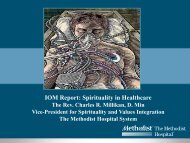
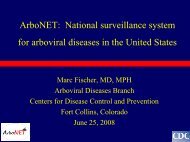

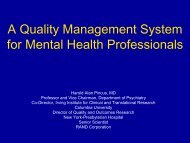
![Barry Davis Presentation.ppt [Read-Only] - Institute of Medicine](https://img.yumpu.com/31160415/1/190x146/barry-davis-presentationppt-read-only-institute-of-medicine.jpg?quality=85)
